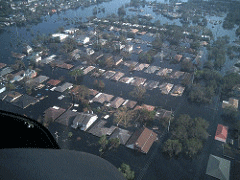
Think about the long term and create a plan that stretches from recovery to reconstruction. Start from your goal and engineer backward. As much as possible, design and orient emergency interventions that can be effectively transitioned to permanent housing and development of communities.
Engage the community. A common phrase in disaster response work is “nothing about us without us.” There is so much wisdom in those words. As we work to rebuild communities, we must keep the people who live there at the center of our plans. It doesn’t make for a faster process, and sometimes things get messy, but pays off tremendously. . . .
Coordinate efforts and be mindful of the contributions of all. Corporations, charities, nonprofits, governments, communities of faith and civic organizations are entrusted with the public’s money to help those affected by disaster. Extraordinary efforts must be made to avoid duplication of services and to leverage one another’s efforts to use limited resources for the maximum good. It is also important to note that in addition to the organizations that you might expect onsite, some unlikely players also can make meaningful contributions. For example, optometrists based outside the Gulf region helped people fill prescriptions to replace lost eyeglasses.
Encourage local governments to invest in their own training. It is the role of government to lead a community’s response to disaster. Just as nonprofits and other organizations invest in preparedness, local governments must prepare as well. Walter Maddox is the mayor of Tuscaloosa, Alabama, which suffered tremendous damage from a 2011 tornado. He had sent 60 members of his staff for FEMA training two years before the storm and said the skills learned at that training did more to help Tuscaloosa handle the disaster than anything else.
A community-based disaster preparedness and mitigation program that takes into account all citizens reinforces traditional community values such as self-help, resourcefulness, and cooperation. Nothing can completely prepare a community to respond to the unexpected, but there are many things governments can do to be poised for response rather than having to learn under extreme pressure.
Capture impact. Habitat for Humanity has built, renovated, or repaired more than 6,000 houses in the Gulf region since the hurricanes. And although we have been gathering data and have some good information concerning our impact in the area, we do not have a complete picture. We can do a better job of documenting the results of our efforts, including successes, near-misses, and failures. That includes acquiring both measurable data and the personal stories of those we serve.
No doubt we will learn more as we continue responding to disasters—like the recent earthquakes in Nepal. Regardless of the place or community impacted, let's remember that rebuilding after large-scale disasters, if done right, is a slow process. Rather than succumbing to the pressure of delivering quickly at whatever the cost, let's focus on the outcome we want to see: communities restored and coming back stronger than before, communities better prepared for what may come next.
What will our strategies be to create pathways to permanence?
(Photo credit: 'Hurricane Katrina LA3' by News Muse, CC BY-NC-ND 2.0)






What we’ve learned thru personal stories can be a powerful tool in educating and getting community participation
Thanks Alice. You’re so right. We’ve found that we need the data to know what works but that stories change hearts.